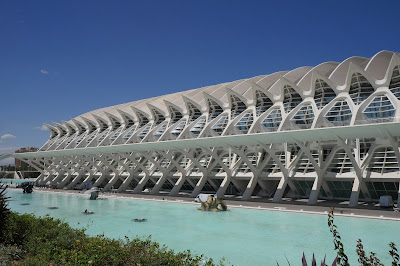One of the most extraordinary things about Valencia is the Turia Gardens. The River Turia, which arcs around the old town, had repeatedly flooded the city and after a particularly devastating flood on 14 October 1957 it was decided to divert its course some way upstream. It now reaches the sea to the south of the city and the former river bed has been turned into an immense linear park, 9km in length. The gardens were inaugurated in 1986 and comprise areas of a very different character from football pitches to children's play areas. The astonishing City of Arts and Sciences is at the end nearest the sea.
We started our day with a visit to the interesting Bellas Artes Museum. We then passed through the disappointing Royal Gardens, a conventional park, and joined the Turia Gardens at the Royal Bridge. Bridges are a key feature of the park, although the initial effect feels somewhat incongruous.
The park is quite wide at this point are there are several broadly parallel paths you can take. We took a middle line and soon reached the next bridge, the modern and rather striking Puente de la Exposition by Santiago Calatrava.
I had secretly hoped that the park might be home to some butterflies and was delighted when Ange spotted a Swallowtail while I was photographing the bridge. Apart from a few Geranium Bronzes and Whites that was it however.
We passed a funfair to reach the next bridge: the Puente Real, a magnificent affair with a small lake underneath and remarkable canopies housing statues at one end. It was at its most attractive seen through a screen of pine trees. It was rebuilt in 1519.
The final bridge was a nice, fairly minimalist, art deco number.
We spotted a bar area in the shady overhang and enjoyed a quiet drink there listening to an excellent play list of mainly 60s and 70s music. Ahead of us, seen under a road bridge were two more strange structures. On the left the end of the Prince Felipe Museum of the Sciences and on the right the Hemispheric, a cinema and the first building to be completed of the City in 1998. Everything we could see seemed so futuristic, that we were disappointed there were no robots or androids. Perhaps there were ...
Here is a side-on view of the Hemisferic, which houses a cinema, planetarium and a laserium.
Here is one of the Museo de les Ciences (2000). Its design is supposed to evoke the skeleton of a whale.
We thought the way in which all the buildings were connected by and to water was really interesting. It seems to reference the fact the site was once a river, but also serves to enhance the buildings.
Beyond the Science Museum was the wonderful l'Assut d'Or bridge designed by Santiago Calatrava, shown here with the purple Agora, a covered venue for concerts and sporting events, behind it.
The remaining buildings are the Umbracle (2009), an open structure enveloping a landscaped walk with plant species indigenous to Valencia and a sculpture walk …
… and the Oceanografic (2003), designed by Félix Candela. It is the largest oceanographic aquarium in Europe.
Conditions: sunny and very hot, 34 degrees.
Distance: about 3 miles - we took a taxi back to our hotel.
Rating: 5 stars. The Gardens are a delight but the City of Arts and Sciences is truly astonishing.
Distance: about 3 miles - we took a taxi back to our hotel.
Rating: 5 stars. The Gardens are a delight but the City of Arts and Sciences is truly astonishing.












No comments:
Post a Comment